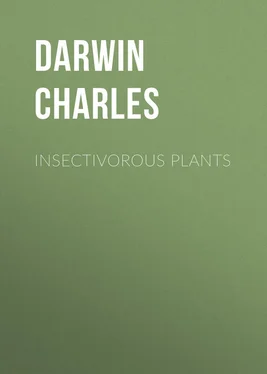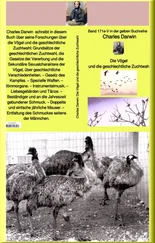Charles Darwin - Insectivorous Plants
Здесь есть возможность читать онлайн «Charles Darwin - Insectivorous Plants» — ознакомительный отрывок электронной книги совершенно бесплатно, а после прочтения отрывка купить полную версию. В некоторых случаях можно слушать аудио, скачать через торрент в формате fb2 и присутствует краткое содержание. Жанр: foreign_antique, foreign_prose, на английском языке. Описание произведения, (предисловие) а так же отзывы посетителей доступны на портале библиотеки ЛибКат.
- Название:Insectivorous Plants
- Автор:
- Жанр:
- Год:неизвестен
- ISBN:нет данных
- Рейтинг книги:5 / 5. Голосов: 1
-
Избранное:Добавить в избранное
- Отзывы:
-
Ваша оценка:
- 100
- 1
- 2
- 3
- 4
- 5
Insectivorous Plants: краткое содержание, описание и аннотация
Предлагаем к чтению аннотацию, описание, краткое содержание или предисловие (зависит от того, что написал сам автор книги «Insectivorous Plants»). Если вы не нашли необходимую информацию о книге — напишите в комментариях, мы постараемся отыскать её.
Insectivorous Plants — читать онлайн ознакомительный отрывок
Ниже представлен текст книги, разбитый по страницам. Система сохранения места последней прочитанной страницы, позволяет с удобством читать онлайн бесплатно книгу «Insectivorous Plants», без необходимости каждый раз заново искать на чём Вы остановились. Поставьте закладку, и сможете в любой момент перейти на страницу, на которой закончили чтение.
Интервал:
Закладка:
Altogether I experimented on sixty-four leaves with the above nitrogenous fluids, the five leaves tried only with the extremely weak solution of isinglass not being included, nor the numerous trials subsequently made, of which no exact account was kept. Of these sixty-four leaves, sixty-three had their tentacles and often their blades well inflected. The one which failed was probably too old and torpid. But to obtain so large a proportion of successful cases, care must be taken to select young and active leaves. Leaves in this condition were chosen with equal care for the sixty-one trials with non-nitrogenous fluids (water not included); and we have seen that not one of these was in the least affected. We may therefore safely conclude that in the sixty-four experiments with nitrogenous fluids the inflection of the exterior tentacles was due to the absorption of nitrogenous matter by the glands of the tentacles on the disc.
Some of the leaves which were not affected by the non-nitrogenous fluids were, as above stated, immediately afterwards tested with bits of meat, and were thus proved to be in an active condition. But in addition to these trials, twenty-three of the leaves, with drops of gum, syrup, or starch, still lying on their discs, which had produced no effect in the course of between 24 hrs. and 48 hrs., were then tested with drops of milk, urine, or albumen. Of the twenty-three leaves thus treated, seventeen had their tentacles, and in some cases their blades, well inflected; but their powers were somewhat impaired, for the rate of movement was decidedly slower than when fresh leaves were treated with these same nitrogenous fluids. This impairment, as well as the insensibility of six of the leaves, may be attributed to injury from exosmose, caused by the density of the fluids placed on their discs.
[The results of a few other experiments with nitrogenous fluids may be here conveniently given. Decoctions of some vegetables, known to be rich in nitrogen, were made, and these acted like animal fluids. Thus, a few green peas were boiled for some time in distilled water, and the moderately thick decoction thus made was allowed to settle. Drops of the superincumbent fluid were placed on four leaves, and when these were looked at after 16 hrs., the tentacles and blades of all were found strongly inflected. I infer from a remark by Gerhardt 16 16 Watts' 'Dictionary of Chemistry,' vol. iii., p. 568. 'Leons sur la Phys. de la Digestion,' tom. i, p. 379; tom. ii. pp. 154, 166, on legumin.
that legumin is present in peas "in combination with an alkali, forming an incoagulable solution," and this would mingle with boiling water. I may mention, in relation to the above and following experiments, that according to Schiff certain forms of albumen exist which are not coagulated by boiling water, but are converted into soluble peptones.
On three occasions chopped cabbage-leaves 17 17 The leaves of young plants, before the heart is formed, such as were used by me, contain 2.1 per cent. of albuminous matter, and the outer leaves of mature plants 1.6 per cent. Watts' 'Dictionary of Chemistry,' vol. i. p. 653.
were boiled in distilled water for 1 hr. or for 1 1/4 hr.; and by decanting the decoction after it had been allowed to rest, a pale dirty green fluid was obtained. The usual-sized drops were placed on thirteen leaves. Their tentacles and blades were inflected after 4 hrs. to a quite extraordinary degree. Next day the protoplasm within the cells of the tentacles was found aggregated in the most strongly marked manner. I also touched the viscid secretion round the glands of several tentacles with minute drops of the decoction on the head of a small pin, and they became well inflected in a few minutes. The fluid proving so powerful, one part was diluted with three of water, and drops were placed on the discs of five leaves; and these next morning were so much acted on that their blades were completely doubled over. We thus see that a decoction of cabbage-leaves is nearly or quite as potent as an infusion of raw meat.
About the same quantity of chopped cabbage-leaves and of distilled water, as in the last experiment, were kept in a vessel for 20 hrs. in a hot closet, but not heated to near the boiling-point. Drops of this infusion were placed on four leaves. One of these, after 23 hrs., was much inflected; a second slightly; a third had only the submarginal tentacles inflected; and the fourth was not at all affected. The power of this infusion is therefore very much less than that of the decoction; and it is clear that the immersion of cabbage-leaves for an hour in water at the boiling temperature is much more efficient in extracting matter which excites Drosera than immersion during many hours in warm water. Perhaps the contents of the cells are protected (as Schiff remarks with respect to legumin) by the walls being formed of cellulose, and that until these are ruptured by boiling-water, but little of the contained albuminous matter is dissolved. We know from the strong odour of cooked cabbage-leaves that boiling water produces some chemical change in them, and that they are thus rendered far more digestible and nutritious to man. It is therefore an interesting fact that water at this temperature extracts matter from them which excites Drosera to an extraordinary degree.
Grasses contain far less nitrogenous matter than do peas or cabbages. The leaves and stalks of three common kinds were chopped and boiled for some time in distilled water. Drops of this decoction (after having stood for 24 hrs.) were placed on six leaves, and acted in a rather peculiar manner, of which other instances will be given in the seventh chapter on the salts of ammonia. After 2 hrs. 30 m. four of the leaves had their blades greatly inflected, but not their exterior tentacles; and so it was with all six leaves after 24 hrs. Two days afterwards the blades, as well as the few submarginal tentacles which had been inflected, all re-expanded; and much of the fluid on their discs was by this time absorbed. It appears that the decoction strongly excites the glands on the disc, causing the blade to be quickly and greatly inflected; but that the stimulus, differently from what occurs in ordinary cases, does not spread, or only in a feeble degree, to the exterior tentacles.
I may here add that one part of the extract of belladonna (procured from a druggist) was dissolved in 437 of water, and drops were placed on six leaves. Next day all six were somewhat inflected, and after 48 hrs. were completely re-expanded. It was not the included atropine which produced this effect, for I subsequently ascertained that it is quite powerless. I also procured some extract of hyoscyamus from three shops, and made infusions of the same strength as before. Of these three infusions, only one acted on some of the leaves, which were tried. Though druggists believe that all the albumen is precipitated in the preparation of these drugs, I cannot doubt that some is occasionally retained; and a trace would be sufficient to excite the more sensitive leaves of Drosera.
CHAPTER VI
The secretion rendered acid by the direct and indirect excitement of the glands – Nature of the acid – Digestible substances – Albumen, its digestion arrested by alkalies, recommences by the addition of an acid – Meat – Fibrin – Syntonin – Areolar tissue – Cartilage – Fibro-cartilage – Bone – Enamel and dentine – Phosphate of lime – Fibrous basis of bone – Gelatine – Chondrin – Milk, casein and cheese – Gluten – Legumin – Pollen – Globulin – Haematin – Indigestible substances – Epidermic productions – Fibro-elastic tissue – Mucin – Pepsin – Urea – Chitine – Cellulose – Gun-cotton – Chlorophyll – Fat and oil – Starch – Action of the secretion on living seeds – Summary and concluding remarks.
Читать дальшеИнтервал:
Закладка:
Похожие книги на «Insectivorous Plants»
Представляем Вашему вниманию похожие книги на «Insectivorous Plants» списком для выбора. Мы отобрали схожую по названию и смыслу литературу в надежде предоставить читателям больше вариантов отыскать новые, интересные, ещё непрочитанные произведения.
Обсуждение, отзывы о книге «Insectivorous Plants» и просто собственные мнения читателей. Оставьте ваши комментарии, напишите, что Вы думаете о произведении, его смысле или главных героях. Укажите что конкретно понравилось, а что нет, и почему Вы так считаете.












